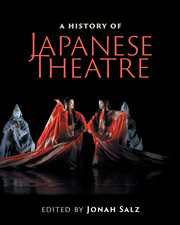Book contents
- Frontmatter
- Contents
- List of figures
- List of tables
- Contributors
- Contributors’ biographies
- Foreword
- Acknowledgments
- Note on Japanese terms
- List of abbreviations
- Timeline
- Editor's introduction
- I Traditional theatres
- Preface to Part I Japanese civilization arises
- 1 Ancient and early medieval performing arts
- Interlude Katari narrative traditions: from storytelling to theatre
- 2 Noh and Muromachi culture
- Interlude Noh and kyogen costumes and masks
- 3 Kyogen: classical comedy
- Interlude Iemoto : the family head system
- 4 Kabuki: superheroes and femmes fatales
- Interlude Nihonbuyo: classical dance
- Interlude Okinawan theatre: boundary of Japanese theatre
- 5 Bunraku: puppet theatre
- Interlude Misemono and rakugo : sideshows and storytelling
- Interlude Kamigata geinō : Kyoto-Osaka style
- Interlude Traditional theatre tomorrow: interview with Takemoto Mikio
- II Modern theatres
- Preface to Part II
- III Arcs and patterns
- IV Theatre architecture
- Preface to Part IV Evolution of Japanese theatre architecture
- V Theatre criticism
- VI Intercultural influences
- Epilogue: Frozen words and mythology
- Further reading
- Index
- References
3 - Kyogen: classical comedy
from Preface to Part I Japanese civilization arises
Published online by Cambridge University Press: 05 July 2016
- Frontmatter
- Contents
- List of figures
- List of tables
- Contributors
- Contributors’ biographies
- Foreword
- Acknowledgments
- Note on Japanese terms
- List of abbreviations
- Timeline
- Editor's introduction
- I Traditional theatres
- Preface to Part I Japanese civilization arises
- 1 Ancient and early medieval performing arts
- Interlude Katari narrative traditions: from storytelling to theatre
- 2 Noh and Muromachi culture
- Interlude Noh and kyogen costumes and masks
- 3 Kyogen: classical comedy
- Interlude Iemoto : the family head system
- 4 Kabuki: superheroes and femmes fatales
- Interlude Nihonbuyo: classical dance
- Interlude Okinawan theatre: boundary of Japanese theatre
- 5 Bunraku: puppet theatre
- Interlude Misemono and rakugo : sideshows and storytelling
- Interlude Kamigata geinō : Kyoto-Osaka style
- Interlude Traditional theatre tomorrow: interview with Takemoto Mikio
- II Modern theatres
- Preface to Part II
- III Arcs and patterns
- IV Theatre architecture
- Preface to Part IV Evolution of Japanese theatre architecture
- V Theatre criticism
- VI Intercultural influences
- Epilogue: Frozen words and mythology
- Further reading
- Index
- References
Summary
Kyogen (狂言) are short classical comic plays performed with stylized vocalization and gestures. Developed from sketches in variety acts comprising sangaku entertainments (later called sarugaku), by the early fourteenth century they incorporated medieval Buddhist and secular folktales and anecdotes, proverbs, and popular songs. Plots range from auspicious dance to comedy of manners, slapstick to dark comedy, absurd fantasy to noh parody. Most plays feature two or three characters and no set, with only fans for properties. Kyogen became paired with noh by the mid-fifteenth century, serving three functions: in the role of the old man Sambasō in Okina (Shiki-sanban), “a person from the area” in ai narrative interludes between acts of noh plays, and in their own independent comedies.
Kyogen developed as freewheeling, popular, festive entertainment during the Muromachi period (1392–1573), its improvisatory verve comparable to that of Roman comedy, miracle plays, or commedia dell'arte traditions. From the late Muromachi period and throughout the Edo period (1603–1868), aristocratic patronage was generous, but as samurai bureaucrats succeeded to power they limited performers to authorized, guild-like schools attached exclusively to one of four official noh schools (Kanze, Hōshō, Komparu, Kongō [and Kita from 1619]). Shogunal authorities demanded titles, and later scripts, be submitted, and kyogen became accordingly codified, as befitting “ceremonial entertainment” (shikigaku 式楽). However, the fluctuating fortunes of the aristocracy, and regional daimyo sponsorship of noh, dispersed branch families widely throughout the country. Other families especially in the Kansai region (Kyoto, Osaka, Nara) continued as popular entertainers at temples, shrines, and the imperial household.
Following the dissolution of the shogunate in 1868 and consequent loss of patronage, kyogen actors sought new teaching and performance outlets at shrines and temples, culture centers, civic halls, and schools. Since World War II, kyogen has experienced unprecedented waves of popular and scholarly attention, fueled by innovative young actors of the extant schools, Okura and Izumi. New audiences have discovered in kyogen's stylized classicism the dynamic earthiness of secular medieval satire and farce, and native techniques of vocalization and dramaturgy.
ELEMENTS OF PERFORMANCE: KYOGEN TODAY
Kyogen is traditional physical theatre par excellence. Actors announce their identities and motives in carefully enunciated declamations, creating an imaginative stage space through exaggerated physical expression and stylized yet detailed mime.
- Type
- Chapter
- Information
- A History of Japanese Theatre , pp. 68 - 98Publisher: Cambridge University PressPrint publication year: 2016



